Trumpet daffodils are some of the showiest spring flowers that come back every year. First, their big blossoms have long and impressive frilly cups. Second, their long-lasting flowers on sturdy stems earn trumpet daffodils high praise from gardeners and floral designers. So let’s marvel at some of the most popular types of trumpet daffodils, from heirloom yellow varieties to bicolor hybrids. Each of the 10 trumpet daffodils below proves how showy any daffodil garden bed can be.
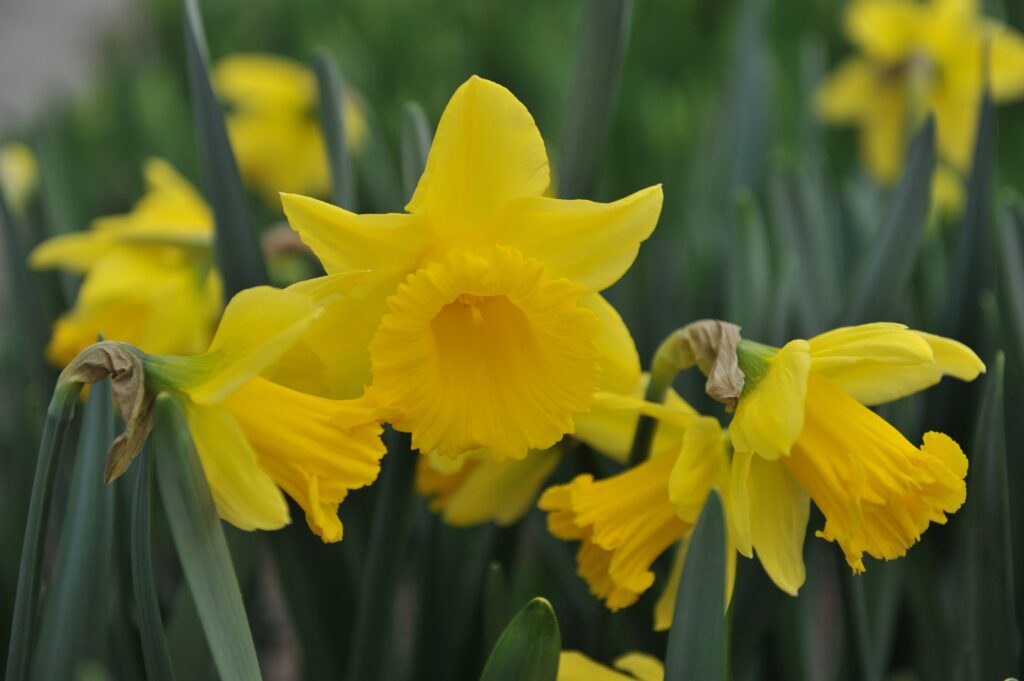
Trumpet daffodil plants usually produce only one flower per stem.
©Sergey V Kalyakin/Shutterstock.com
What Are Trumpet Daffodils?
A trumpet daffodil is one of the most recognized and popular daffodil varieties. You can identify this iconic daffodil by two important traits:
- Trumpet daffodils produce one flower per plant stem.
- This flower’s cups (also called coronas) have trumpet shapes that grow as long as or possibly longer than its petals.
Other common traits of trumpet daffodils include cups with ruffled edges, a subtle sweet scent, and big 3-5 inch blooms.
Of the 13 divisions used to classify daffodils, trumpet daffodils are at the very top in Division #1. Do you know what varieties are in the other 12 daffodil divisions? Here’s a complete list of all daffodil divisions for quick reference.
- Div. #1: Trumpet Daffodils
- Div. #2: Large-Cupped Daffodils
- Div #3: Small-Cupped Daffodils
- Div #4: Double Daffodils
- Div #5: Triandrus Daffodils
- Div #6: Cyclamineus Daffodils
- Div #7: Jonquilla Daffodils
- Div #8: Tazetta Daffodils
- Div #9: Poeticus Daffodils
- Div #10: Bulbocodium Daffodils
- Div #11a: Split-Cupped Collar Daffodils
- Div #11b: Split-Cupped Papillion Daffodils
- Div #12: Other Daffodil Cultivars
- Div #13: Daffodils Categorized Only by Botanical Name
Let’s look at some showy types of trumpet daffodils you might want to grow for incredible spring blooms!
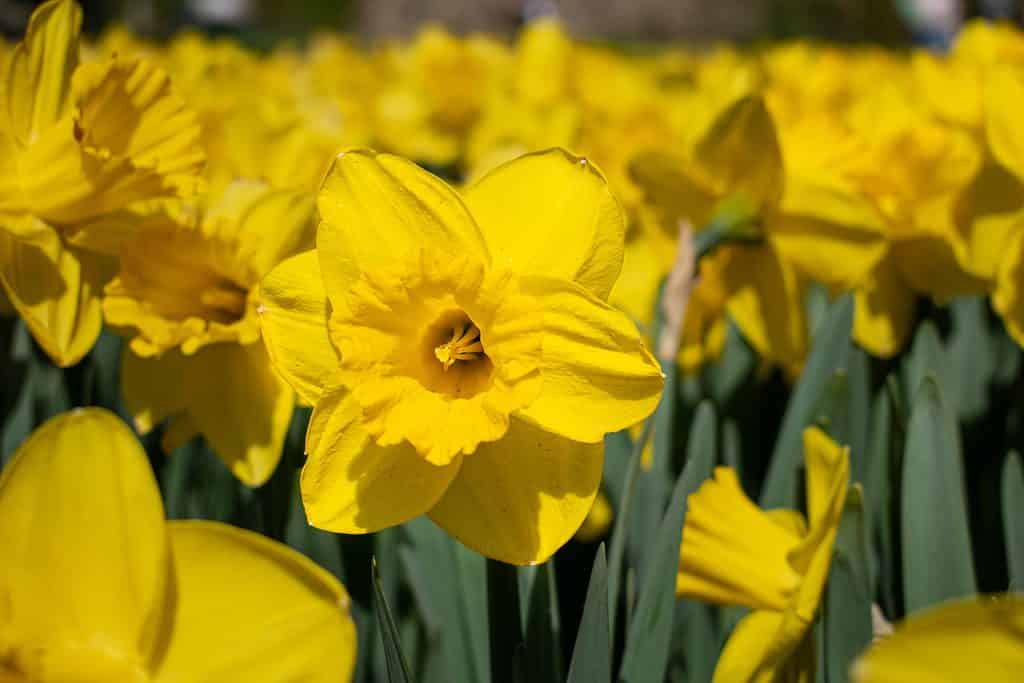
The golden yellow ‘Dutch Master’ cultivar is a standout type of trumpet daffodil.
©Dajbog Nicoleta/Shutterstock.com
1. Narcissus ‘Dutch Master’
Botanical Name: Narcissus ‘Dutch Master’
Common Names: ‘Dutch Master’ Daffodil, ‘Dutch Master’ Trumpet Daffodil
Hardiness Zones: 3-9
Blooming Season: Mid-Spring
Daffodil Division: Trumpet (Division #1)
Flower Colors: Golden yellow
Awards: The Award of Garden Merit – The Royal Horticultural Society
Stunning ‘Dutch Master’ is a type of trumpet daffodil with 4-inch blooms the color of sunshine. This mid-spring bloomer with golden yellow petals and cups grows up to 18 inches high. With its elegantly ruffled trumpets, this cultivar has a classic daffodil style.
‘Dutch Master’ is a vigorous heirloom plant first introduced in the 1930s. So it’s been proving itself to be a hardy, beautiful plant for nearly a century! The ‘Dutch Master’ also naturalizes well in Zones 3-9.
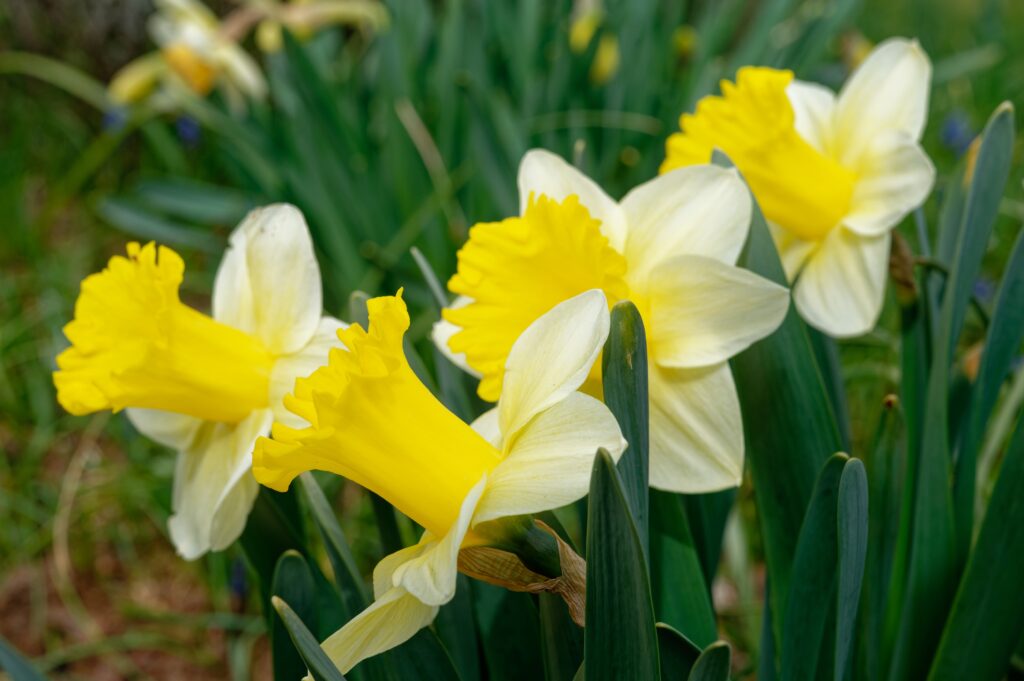
‘Goblet’ is a bicolor trumpet daffodil with white petals and yellow cups.
©Walter Erhardt/Shutterstock.com
2. Narcissus ‘Goblet’
Botanical Name: Narcissus ‘Goblet’
Common Names: ‘Goblet’ Daffodil, ‘Goblet’ Trumpet Daffodil
Hardiness Zones: 3-9
Blooming Season: Early to Mid-Spring
Daffodil Division: Trumpet (Division #1)
Flower Colors: Bright white petals with lemon yellow cups that mature to pale yellow
The ‘Goblet’ trumpet daffodil is another heirloom variety introduced in the 1950s. This tall, stately plant produces 4-inch bicolor blooms with white petals and bright yellow cups. Even though its yellow cups will fade as the flowers mature, ‘Goblet’ is a standout daffodil from early to mid-spring.
‘Goblet’ trumpet daffodils grow an average of 16-18 inches tall in Zones 3-9.
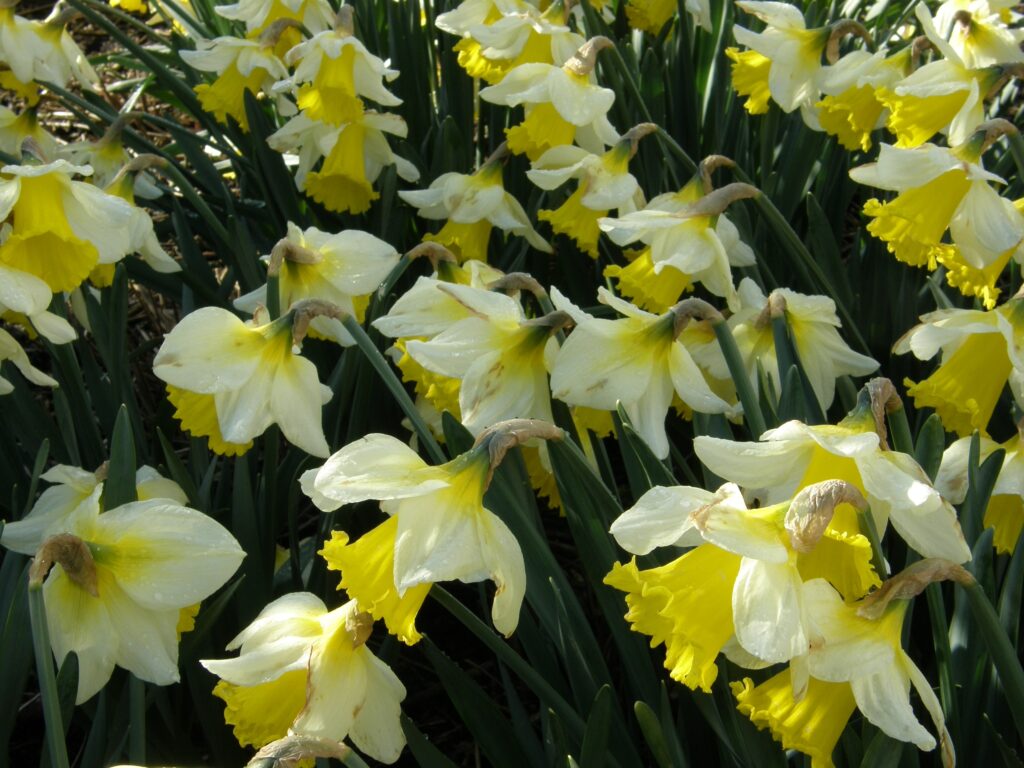
Bicolor ‘Holland Sensation’ trumpet daffodil blooms early to mid-spring.
©Sergey V Kalyakin/Shutterstock.com
3. Narcissus ‘Holland Sensation’
Botanical Name: Narcissus ‘Holland Sensation’
Common Names: ‘Holland Sensation’ Daffodil, ‘Holland Sensation’ Trumpet Daffodil
Hardiness Zones: 3-9
Blooming Season: Early to Mid-Spring
Daffodil Division: Trumpet (Division #1)
Flower Colors: White petals and bright yellow cups with orange coronas
The ‘Holland Sensation’ trumpet daffodil is another bicolor variety with striking white petals and vivid yellow cups. This pretty hybrid plant grows 1-2 feet tall and blooms in March and April. It also makes an excellent cut flower for spring arrangements. For example, these large and long-lasting blooms are ideal for fresh daffodil wedding bouquets.
‘Holland Sensation’ naturalizes beautifully, especially when planted in large groupings.
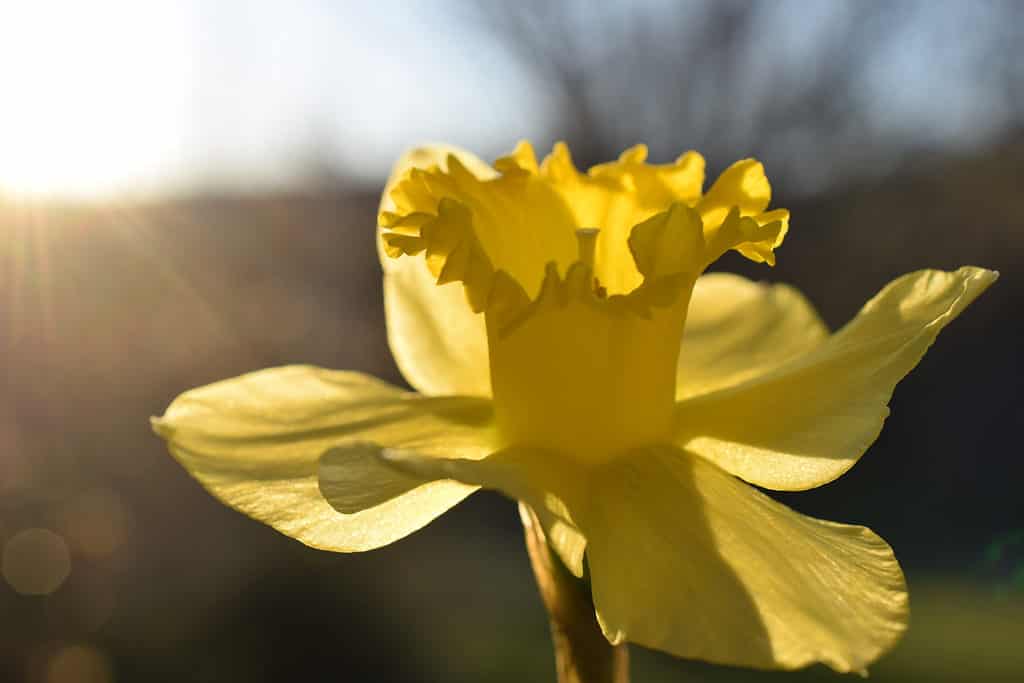
The ‘King Alfred’ trumpet daffodil is now a rare heirloom blub flower first introduced in the late 1800s.
©Tracy Burroughs Brown/Shutterstock.com
4. Narcissus ‘King Alfred’
Botanical Name: Narcissus ‘King Alfred’
Common Names: The Lent Lily, ‘King Alfred’ Daffodil
Hardiness Zones: 3-8
Blooming Season: Early to Mid-Spring
Daffodil Division: Trumpet (Division #1)
Flower Colors: All yellow
Cultivar Availability: Rare and might be expensive
‘King Alfred’ is a famously magnificent all-yellow trumpet daffodil that isn’t as available for home gardens now as it was years ago. Initially introduced in the late 1800s, ‘King Alfred’ is worth mentioning because it’s a beloved part of daffodil history. And you can still find bulbs for this cultivar from specialty growers. However, they might be expensive compared to other trumpet varieties.
With classic ruffled cups on 4-5 inch flowers, ‘King Alfred’ has big showy blooms. And this type of trumpet daffodil grows 12-24 inches tall.
Can’t find ‘King Alfred’ bulbs? Consider growing look-alike ‘Dutch Master’ trumpet daffodils instead.
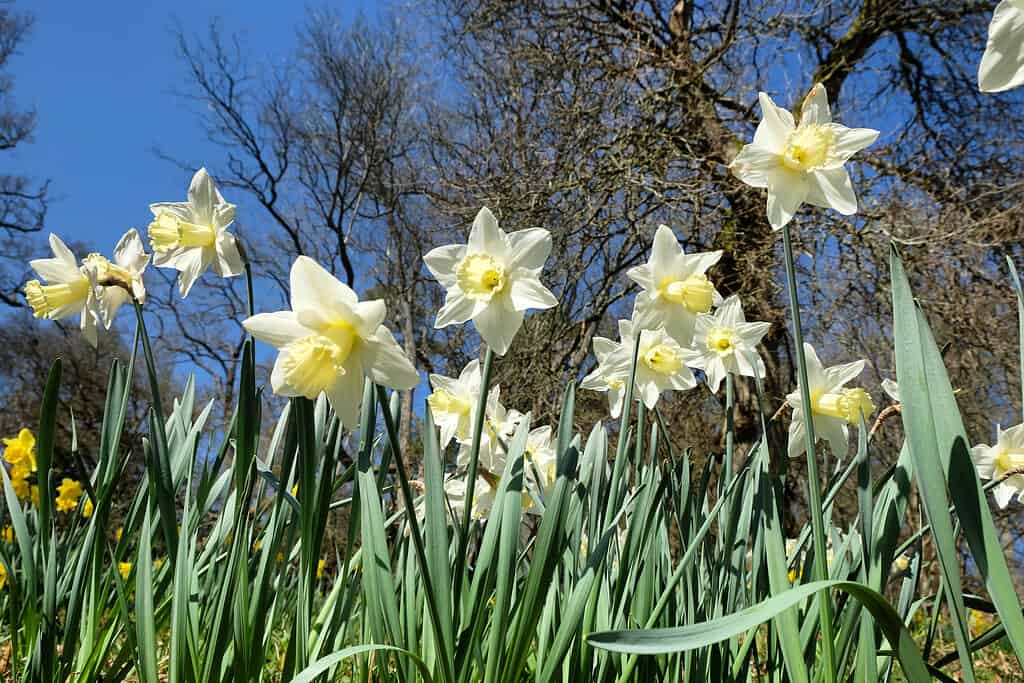
Creamy ‘Mount Hood’ trumpet daffodils have pale yellow cups that fade to white.
©Alex Manders/Shutterstock.com
5. Narcissus ‘Mount Hood’
Botanical Name: Narcissus‘Mount Hood’
Common Names: ‘Mount Hood’ Daffodil, ‘Mount Hood’ Trumpet Daffodil
Hardiness Zones: 3-9
Blooming Season: Mid-Spring
Daffodil Division: Trumpet (Division #1)
Flower Colors: Creamy white petals with a light yellow cup that fades to white
Awards: The John and Gertrude Wister Award – The American Daffodil Society, The Award of Garden Merit – The Royal Horticultural Society
If you’re looking for an elegant creamy daffodil perfect for cottage gardens, consider growing the ‘Mount Hood’ cultivar! This lovely trumpet daffodil is a favorite heirloom variety with white petals and pale yellow cups that eventually mature to white.
‘Mount Hood’ flowers tick all the boxes of big, frilly, and showy daffodils. They also grow 1-2 feet high and produce 4-inch blooms.
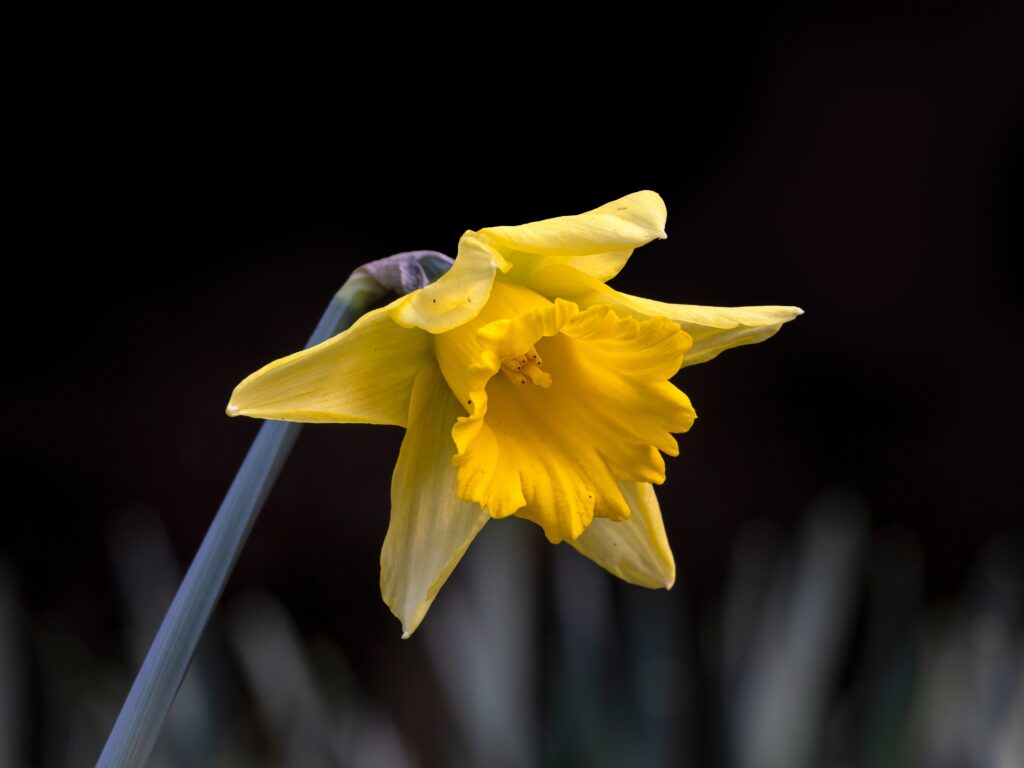
The ‘Rijnveld’s Early Sensation’ cultivar is an award-winning yellow trumpet daffodil.
©Chris Lawrence Travel/Shutterstock.com
6. Narcissus ‘Rijnveld’s Early Sensation’
Botanical Name: Narcissus ‘Rijnveld’s Early Sensation’
Common Names: ‘Rijnveld’s Early Sensation’ Daffodil, ‘Rijnveld’s Early Sensation’ Trumpet Daffodil
Hardiness Zones: 4-8
Blooming Season: Very early spring
Daffodil Division: Trumpet (Division #1)
Flower Colors: Golden yellow
Awards: The Award of Garden Merit – The Royal Horticultural Society
The ‘Rijnveld’s Early Sensation’ trumpet daffodil is a unique variety that blooms in early spring. In addition to its adaptability to late winter weather, this golden yellow flower has striking wide and flared cups on 3-inch blooms.
‘Rijnveld’s Early Sensation’ is an excellent choice for cold climates. It grows an average of 14 inches tall and provides additional blooms year to year.
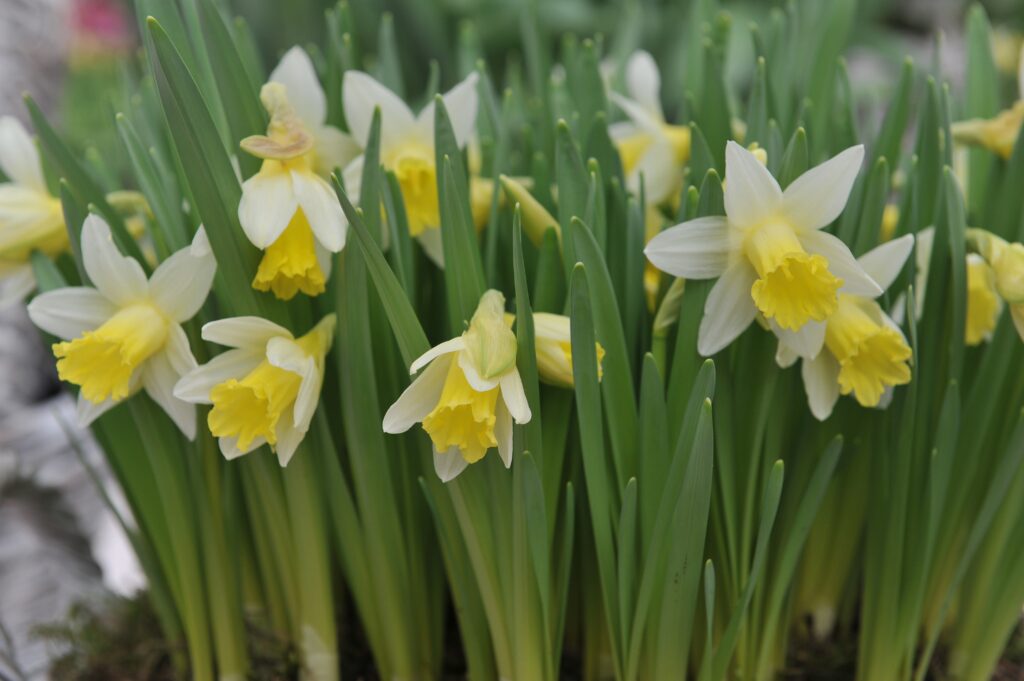
‘Topolino’ is a miniature trumpet daffodil.
©Sergey V Kalyakin/Shutterstock.com
7. Narcissus ‘Topolino’
Botanical Name: Narcissus ‘Topolino’
Common Names: ‘Topolino’ Daffodil, ‘Topolino’ Trumpet Daffodil
Hardiness Zones: 3-8
Blooming Season: Early to Mid-Spring
Daffodil Division: Trumpet (Division #1)
Flower Colors: White petals and yellow cups
Awards: The Award of Garden Merit – The Royal Horticultural Society
As one of the most fragrant trumpet daffodils, the ‘Topolino’ heirloom daffodil is a great choice for adding color and scent to spring gardens. And, with its striking white petals and contrasting yellow cups, this type of trumpet daffodil is sure to make a statement.
The ‘Topolino’ cultivar is a miniature daffodil that grows 8-10 inches tall. So it’s a perfect spring flower for borders and containers.
‘Topolino’ bicolor flowers grow 3 inches wide and show up in early to mid-spring. This cultivar is also easy to grow and naturalizes well in large groupings or long color drifts. Plus, its long-lasting blooms can be enjoyed for weeks.
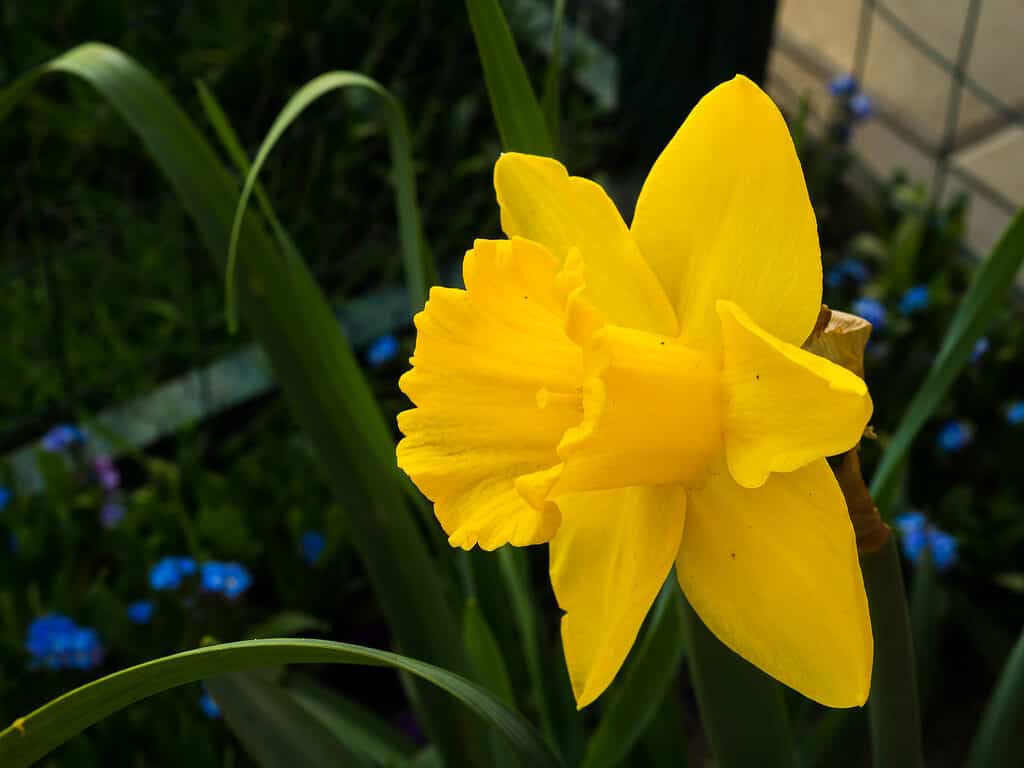
‘Unsurpassable’ and most other trumpet daffodils grow best in Zones 3-9.
©monikozi/Shutterstock.com
8. Narcissus ‘Unsurpassable’
Botanical Name: Narcissus ‘Unsurpassable’
Common Names: ‘Unsurpassable’ Daffodil, ‘Unsurpassable’ Trumpet Daffodil
Hardiness Zones: 3-8
Blooming Season: Early Spring
Daffodil Division: Trumpet (Division #1)
Flower Colors: All Yellow
‘Unsurpassable’ is a showy daffodil with flared trumpet cups and yellow flower charm. Moreover, this type of trumpet daffodil is reliable for an early pop of color before spring fully begins. ‘Unsurpassable’ is also a plant with big, beautiful blooms (4 inches wide) and a vigorous growing habit in Zones 3-8.
This dynamic yellow daffodil grows 1-2 feet high and has the signature trumpet daffodil frilly cups. And you will love that it’s one of the first flowers to greet you as the late winter snow melts away.
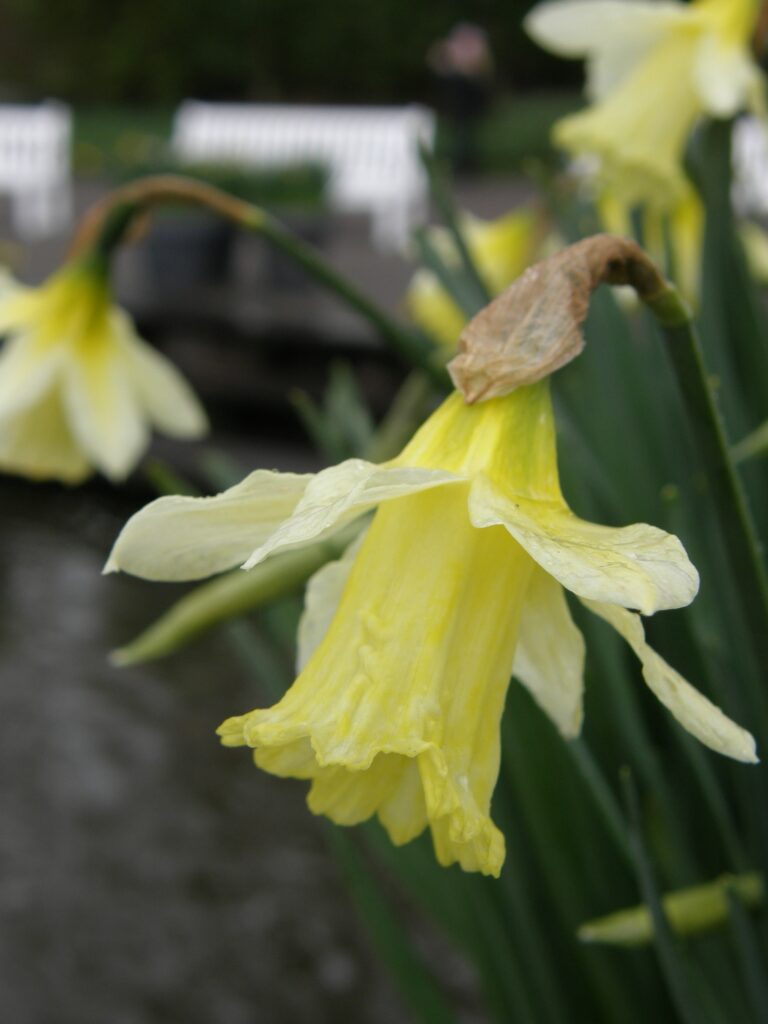
‘W.P. Milner’ heirloom daffodils were first introduced in the Victorian Era.
©Sergey V Kalyakin/Shutterstock.com
9. Narcissus ‘W.P. Milner’
Botanical Name: Narcissus ‘W.P. Milner’
Common Names: ‘W.P. Milner’ Daffodil, ‘W.P. Milner’ Trumpet Daffodil
Hardiness Zones: 3-9
Blooming Season: Early to Mid-Spring
Daffodil Division: Trumpet (Division #1)
Flower Colors: Pale yellow upon opening and then matures to silvery white
Awards: The Award of Garden Merit – The Royal Horticultural Society
The ‘W.P. Milner’ is an old-fashioned daffodil that has been around since the Victorian Era of the late 1800s. It’s also unique to other trumpet daffodils due to its nodding blooms. ‘W.P. Milner’ is a smaller plant that grows about 12 inches high and produces blooms 2-3 inches wide.
This perennial flower opens with faint yellow petals and cups but matures to silvery white. For this reason, ‘W.P. Milner’ is a top choice for garden beds with a touch of Victorian elegance.
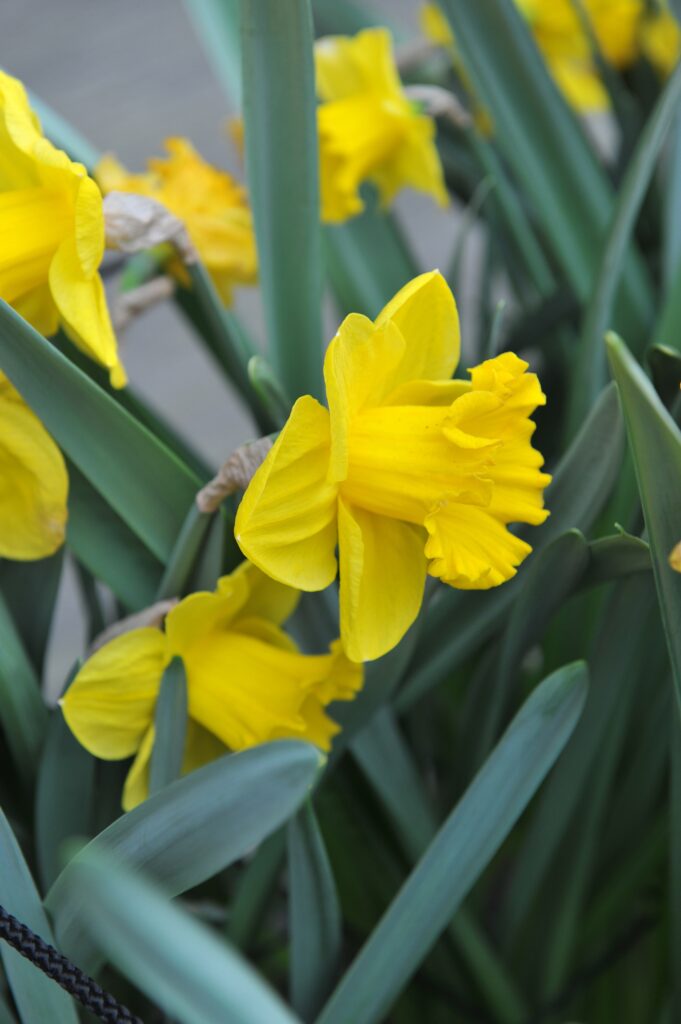
Award-winning ‘Yellow River’ trumpet daffodil grows 15-18 inches tall.
©Sergey V Kalyakin/Shutterstock.com
10. Narcissus ‘Yellow River’
Botanical Name: Narcissus ‘Yellow River’
Common Names: ‘Yellow River’ Daffodil, ‘Yellow River’ Trumpet Daffodil
Hardiness Zones: 3-9
Blooming Season: Mid-Spring
Daffodil Division: Trumpet (Division #1)
Flower Colors: Bright golden yellow
Awards: The Award of Garden Merit – The Royal Horticultural Society
The ‘Yellow River’ is a bright trumpet daffodil with golden yellow flowers and big, ruffled cups. It’s also another very fragrant type of trumpet daffodil, making this cultivar extra popular among similar spring bulb flowers.
‘Yellow River’ grows between 15-18 inches tall and features large 4-inch blooms. And it’s an excellent choice for showy flower beds or containers. Plus, it’s also easy to grow and naturalizes well in group plantings.
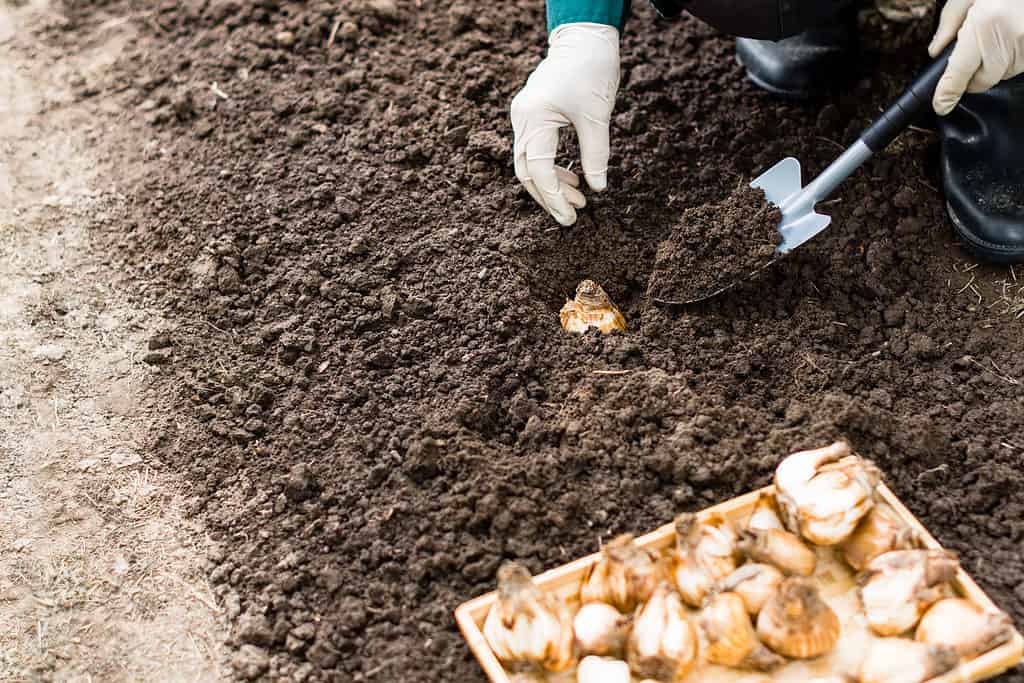
Most daffodil bulbs are easy to grow for gardeners of all experience levels.
©Jurga Jot/Shutterstock.com
Beginner Tips for Daffodil Growers
Daffodils are easy to grow for gardeners of all levels, but it helps to know the best practices for high plant performance. So, to successfully grow daffodils in your garden, here are some helpful tips for beginners:
- Plant your daffodil bulbs in the fall (October-November) for spring blooms. Note that most varieties grow best in Zones 3-9, but some daffodil types, like tazettas, prefer warmer climates.
- Place daffodil bulbs in the ground with their roots facing down and pointed necks facing up.
- Choose a sunny spot in your garden with well-draining soil.
- Place bulbs 4-6 inches below the soil surface and about 4-6 inches apart.
- Allow the plant foliage to die back on its own after blooms fade. This practice gives your daffodil bulbs enough time to store plenty of energy for blooming again the following year.
- Divide the bulbs every few years to promote new growth.
- Plant daffodils in large groups or long drifts, especially for miniature plants that make a bigger impact when blooming together.
With these simple tips, you can easily create a beautiful display of daffodils for your spring garden!
Trumpet Daffodils are Showy and Classic Spring Flowers
Trumpet daffodils are showy spring flowers with iconic shapes and colors. Even better, they’re easy-to-grow classic flowers that capture your heart and attention from early to mid-spring. Plus, trumpet daffodils come in many varieties, from small nodding blooms to large, dramatic single flowers.
Just give your trumpet daffodils a sunny spot to grow in well-drained soil and watch them shine. With a little time and the right growing conditions, trumpet daffs will provide a showy display each spring.
The photo featured at the top of this post is © Jacques Julien/Shutterstock.com
Thank you for reading! Have some feedback for us? Contact the AZ Animals editorial team.






